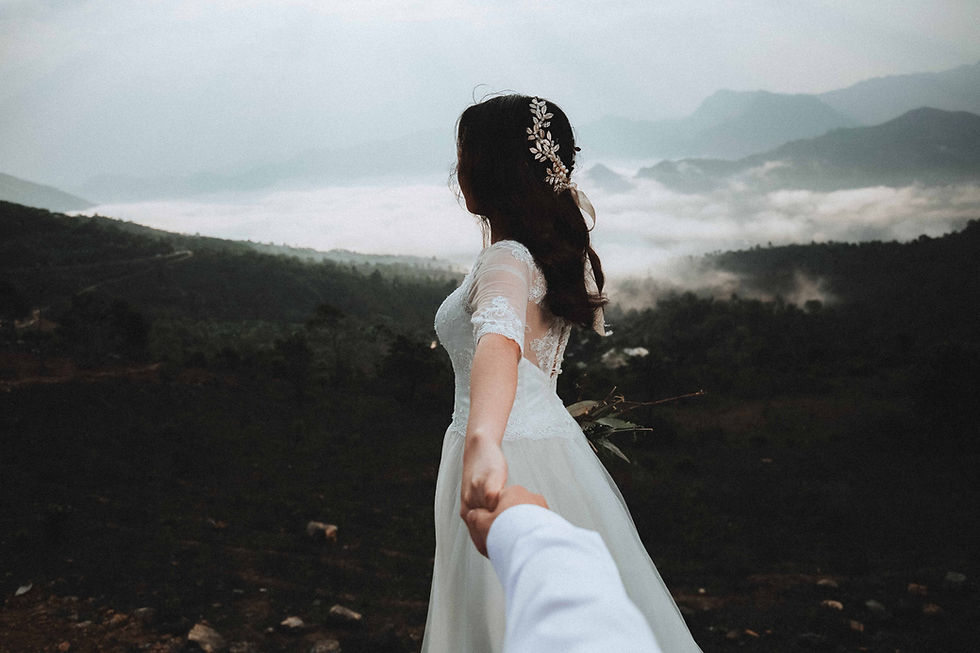Fine Art Wedding Photography: 6 Details That Make Your Photos Stand Out
- Lisette Gatliff

- Sep 3, 2023
- 4 min read

"The devil's in the details" - you've probably heard this adage multiple times in the realm of photography. But it holds especially true for fine art wedding photography: a style that uses storytelling to create timeless works of art.
Ever wondered what makes them unique? In this blog, I've listed 6 details that make your photos stand out using fine art wedding photography.
Cohesive Color Palette
Fine art wedding photography is all about storytelling. And because of that, paying attention to the "colors" is a must. Colors are the window to any visually appealing story as they grip the viewer's emotions from the get-go.
Some popular color palettes in the world of fine arts are neutrals (in shades of white, beige, and gray). Other go-to options are earth tones (green, brown, and rust) and pastels.
However, to empower a seamless flow in storytelling, choosing colors that appeal to you as a couple is best. That way you're sticking to your overall vision as a couple. Plus, sprinkling these colors throughout the decor ensures uniformity in pictures (and storytelling!)
Fabrics
What is the one thing that the bridal gown, groom's tux, tablecloths, veil, and chair covers have in common? Fabrics. Do you see how omnipresent they are? This repetition makes them an essential element of wedding planning (and photography!)
Imagine you're going for a barn-style, rustic wedding and end up using velvet sheets! The contrasting feel of these different elements distorts focus from the big-picture aesthetic (i.e., the rustic wedding). Fine art wedding photography thrives off cohesiveness, so you must consider fabric homogeneity.
Luxurious fabrics like silk, satin, lace, and velvet are cult favorites for fine art wedding photography. However, you choose your favorite fabrics that fit your vision and roll with them in the decor!
Lighting:
Ever wondered where the soft glow in fine art wedding photos comes from? It's all thanks to natural lighting! The ambient light is a go-to for mellow pictures in fine art photography.
The soft, flattering shadows created by natural light give the pictures the sought-after timeless look. Natural light is very flattering to the skin and, when coupled with proper editing, gives off the fairytale vibe.
More so than the type of light, the direction of light is more critical when it comes to the look of the photos. For instance, side lighting is usually preferred for portraits, creating dramaticism in the pictures.
Angles:
Photoshoot angles are significant for fine art wedding photography. They help exude a "feel" to the photographs that are typical to that angle.
Experimenting with the angles is vital to discover which ones synchronize with the overall aesthetic. For example, your photographer can use low angles if you're going for a powerful look.
The "subject" of the pictures is crucial in bringing out the best story through fine art wedding photography. For instance, if you're capturing the intimacy of the bride and groom, high-angle photography is best. Similarly, wide-angle shots are best for capturing the vows and "I do's."
Editing style:
Editing is the final step in taking regular pictures and converting them into works of art. That's why the direction of editing the photographer chooses impacts the overall look and feel of the photos.
You can opt for an editing style that suits your taste as a couple. A natural editing style is the way to go if you want timeless pictures. Alternatively, emotionally evocative fine art photography relies on a more dramatic editing style.
Ultimately the choice is yours. However, keep your photographer in the loop, as they're responsible for bringing your vision to life!
Mood Boards:
Mood boards are the starting point for visualizing any wedding, but more so for a fine art one. This is because fine art weddings rely heavily on storytelling. What better way to paint a perfect picture of your special day than to actually envision it firsthand, right?
Mood boards bring all the elements mentioned above together. It's often step one to wedding planning, but I've intentionally kept it at the last of the tips. That's because most of us have disjointed tastes regarding wedding details. For instance, we might like a beach wedding AND the color burgundy at the same time.
As much as the gurus like to tout otherwise, there is always a way to combine these disparate elements. The mood board helps you see how they all fit together in an overall picture and enables you to implement it efficiently.
Final Thoughts: Fine Art Wedding Photography Details
The best part about fine art wedding photography is that it's a playground for creativity. There are no "shoulds" to be followed here. The only ask is to maintain consistency and uniformity.
Besides, the details we've focused on in this blog (the colors, fabrics, decor, etc.) stand out if they're more significant to you as a couple. That's the beauty of fine art photography — you get to make it truly you.
.png)



Comments